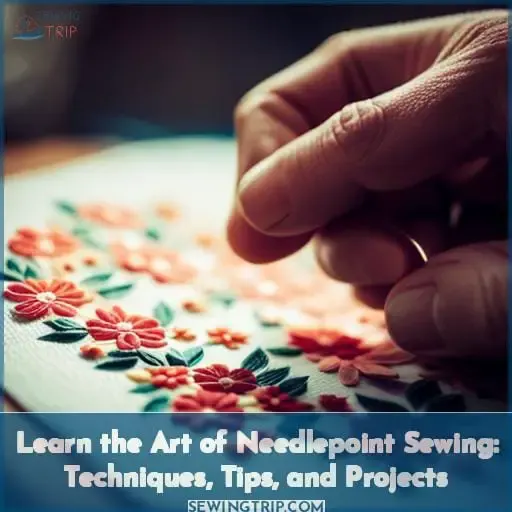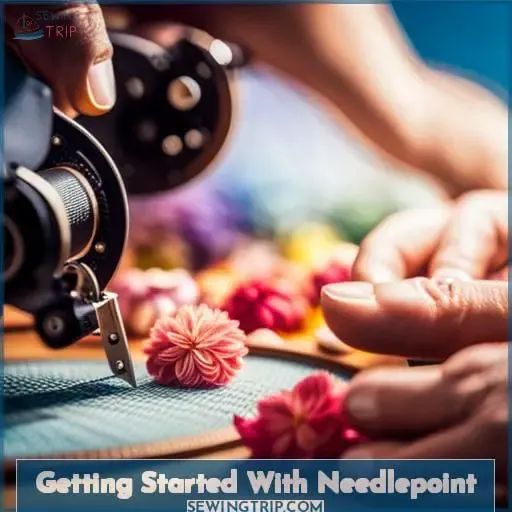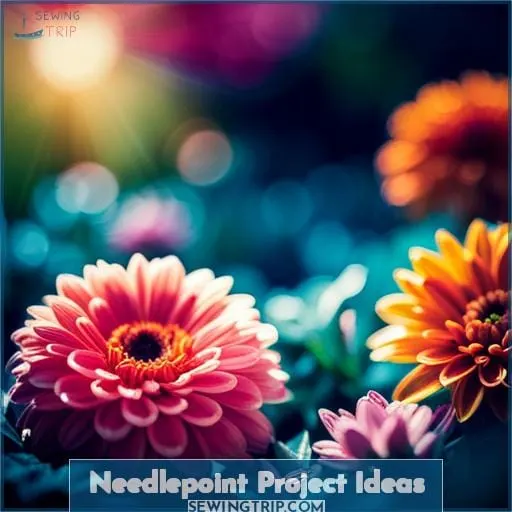This site is supported by our readers. We may earn a commission, at no cost to you, if you purchase through links.
 Ready to dive into the world of needlepoint sewing? Get ready to unleash your creativity and master this timeless art form.
Ready to dive into the world of needlepoint sewing? Get ready to unleash your creativity and master this timeless art form.
In this article, you’ll discover essential techniques, valuable tips, and inspiring projects that will take your needlepoint skills to new heights.
Whether you’re a beginner or an experienced stitcher, there’s something for everyone in the exciting world of needlepoint sewing.
So grab your needles and thread – it’s time to start stitching!
Table Of Contents
Key Takeaways
- Choose a 14-count canvas for beginner-friendly projects.
- Utilize a tapestry needle with a blunt tip for easy stitching on canvas.
- Opt for beginner-friendly materials like wool, cotton, or silk threads.
- Master the half-cross stitch for diagonal lines on the canvas.
Getting Started With Needlepoint
To get started with needlepoint, you’ll need to focus on a few key points:
- Choosing the right canvas and needles
- Selecting the right yarn and thread
- Learning the basic needlepoint stitches
- Gathering essential tools and supplies
The canvas will determine the size of your project, while different needles are used for different types of threads. Yarns can vary in texture and difficulty level, so it’s important to choose ones that are beginner-friendly.
And finally, having the necessary tools such as tapestry needles and frames will make your stitching experience much easier.
Choosing the Right Canvas and Needles
To begin your needlepoint journey, start by selecting the appropriate canvas and needles for your project.
- Choose a 14 count canvas for a beginner-friendly option.
- Use a tapestry needle with a blunt tip to easily stitch on the canvas.
- Consider investing in needlepoint kits that provide all the necessary materials.
By choosing the right tools, you’ll be well-equipped to create beautiful needlepoint designs using techniques like tent stitch and waste knot while also enjoying the process of mastering this art form.
Selecting the Right Yarn and Thread
Now that you have chosen the right canvas and needles for your needlepoint project, let’s move on to selecting the perfect yarn and thread.
As a beginner, it’s best to start with wool, cotton, or silk threads. These materials are easy to work with and provide great results.
Remember to use a blunt tip tapestry needle that matches the size of your thread and canvas for smooth stitching.
Learning the Basic Needlepoint Stitches
Now that you have selected the right yarn and thread, it’s time to learn the basic needlepoint stitches.
These stitches are essential for creating beautiful needlepoint designs.
The half-cross stitch is a simple diagonal stitch that creates a slanted line on your canvas.
The continental stitch is similar to the half-cross, but it creates a straight vertical or horizontal line.
Lastly, the basketweave stitch is a versatile and durable stitch that covers more canvas area with each point sewn.
Mastering these stitches will give you power over your needlepoint projects!
Essential Needlepoint Tools and Supplies
You’ll need a few essential tools and supplies to get started with needlepoint sewing.
The first tool you’ll need is a tapestry needle, preferably one with a blunt tip and size 24 for easy stitching.
Another important supply is a waste knot, which helps secure the threads on the back of your project.
Additionally, having a blocking board handy will be crucial for restoring the shape of your finished design.
With these tools in hand, you’re ready to dive into the world of needlepoint sewing!
Creating Your Needlepoint Design
Now that you have mastered the basics of needlepoint stitching, it’s time to explore your creativity by creating your own designs.
There are a few different ways you can approach this:
- Using a graph or chart for stitching
- Painting a design directly onto the canvas
- Enlarging and printing free needlepoint charts
Each method has its own unique advantages and allows for endless possibilities in designing beautiful needlepoint projects.
Let’s delve into these techniques further and discover how to bring your own unique vision to life through needlepoint sewing.
Using a Graph or Chart for Stitching
To create your needlepoint design, use a graph or chart to guide your stitching and ensure accurate placement of each stitch.
Here are three key techniques for using graphs and charts in needlepoint:
- Gridlines: Some graphs come with gridlines to help you count stitches and maintain the correct proportions.
- Color Coding: Charts often use different colors to represent different thread colors, making it easier to follow along.
- Marking the Canvas: Use a pencil or removable marker to mark important points on the canvas according to the chart.
By counting stitches and following your graph or chart closely, you’ll be able to create beautiful needlepoint designs with precision and mastery!
Painting a Design on Canvas
Continuing from using a graph or chart for stitching, another method of creating your needlepoint design is by painting it directly on the canvas. This allows you to unleash your creativity and add unique details to your project.
You can use different types of paints such as watercolors or acrylics depending on the desired effect.
If you’re not confident in freehand painting, you can also use stencils to create precise designs.
Painting on black canvas adds an extra touch of drama and elegance to your needlepoint artwork.
Enlarging and Printing Free Needlepoint Charts
Now let’s move on to creating your needlepoint design by enlarging and printing free needlepoint charts.
Take advantage of the convenience of online resources that offer a variety of downloadable charts in PDF format. Once downloaded, you can easily save them to your computer for quick access whenever needed.
If you prefer working with a physical copy, simply print the chart using a printer or even take it to a local print shop if necessary.
A scanner can also be useful for capturing existing designs and resizing them as needed.
Tips for Designing Your Own Needlepoint Patterns
As you delve into the world of needlepoint design, consider incorporating your own personal touch by creating unique patterns.
Use simple shapes and freehand techniques to draw on canvas.
Don’t be afraid to experiment and practice until you find a design that speaks to you.
Let your creativity flow as you explore the possibilities of designing your own needlepoint patterns.
Needlepoint Techniques and Tips
Now that you have learned the basic stitches and have gathered your materials, it’s time to explore some important needlepoint techniques and tips.
First, we’ll discuss working with different canvas sizes and fabrics, as this will determine the overall look of your project.
Next, we’ll address how to deal with any warping or shaping issues that may occur during the stitching process.
Finally, we’ll cover blocking and restoring the canvas to ensure a professional finish for your finished needlepoint piece.
Working With Different Canvas Sizes and Fabrics
To successfully navigate the art of needlepoint sewing, it’s essential to understand how to work with different canvas sizes and fabrics.
- Choose between 14ct vs 18ct canvas:
- The higher the count, the finer the fabric.
- Decide between linen vs evenweave canvas:
- Linen has a natural texture while evenweave provides consistent stitches.
- Determine whether mono or multi-canvas suits your project better:
- Mono is single-threaded, while multi has multiple threads woven together for added strength.
Now that you know these important considerations, let’s dive deeper into each one!
Dealing With Warping and Shaping of Finished Projects
When completing a needlepoint project, you may encounter slight warping and shaping that needs to be addressed.
To prevent curling and restore the canvas to its original shape, blocking is necessary.
Blocking techniques involve stretching the finished project on a blocking board using blocking tools such as T-pins or rustproof stainless-steel pins.
This helps create straight edges and smooth out any wrinkles or distortions in your needlepoint masterpiece.
Blocking and Restoring the Canvas
Now let’s explore how to block and restore your needlepoint canvas to ensure it regains its original shape and sizing.
Using a blocking board is key in this process.
Start by pinning the dampened canvas onto the board, making sure it’s taut but not stretched too tightly.
Use blocking tools like T-pins or rustproof pins to secure the edges of the canvas evenly.
Allow it to dry completely before removing from the board, and voila!
Your blocked needlepoint will be smooth and beautifully shaped once again.
Needlepoint Project Ideas
Now that you have learned the essential techniques and tips for needlepoint sewing, let’s explore some exciting project ideas to put your newfound skills to use.
Whether you’re a beginner looking for simple yet satisfying projects or an advanced stitcher seeking challenges, there’s something for everyone in the world of needlepoint. From creating beautiful home decor pieces to personalizing accessories with custom designs, the possibilities are endless when it comes to expressing your creativity through this timeless craft.
Beginner-Friendly Needlepoint Projects
Start your needlepoint journey with beginner-friendly projects that will help you develop your skills and create beautiful pieces.
Choose from a variety of projects, such as small 2×2 or 4×4 designs to practice basic stitches.
You can also try larger 6×6 or 8×8 projects to challenge yourself and expand your creativity.
From simple coasters and bookmarks to decorative wall hangings, there are endless possibilities for beginners to explore in the world of needlepoint projects.
Advanced Needlepoint Designs and Challenges
To tackle more intricate and demanding needlepoint creations, explore advanced designs and challenges that will take your stitching skills to the next level.
Incorporate textured yarns into your projects for added depth and visual interest.
Consider trying more complex stitch patterns, such as bargello or blackwork, to challenge yourself further.
Advanced needlepoint designs can be a great way for experienced stitchers to push their boundaries and achieve mastery in this craft.
Needlepoint for Home Decor and Personal Accessories
Enhance your home decor and add a personal touch to accessories with needlepoint projects.
Needlepoint is perfect for beginners looking to create beautiful, one-of-a-kind pieces.
Start by trying out simple projects like Christmas ornaments or small decorative pillows.
There are plenty of beginner-friendly needlepoint kits available, complete with patterns and all the materials you need to get started.
Let your creativity shine through as you personalize your space with stunning needlepoint designs.
Customizing and Personalizing Needlepoint Projects
Take your needlepoint projects to the next level by adding a personal touch and customizing them to reflect your own style and preferences.
- Add beads for an elegant and textured look.
- Incorporate ribbon for a pop of color and dimension.
- Attach charms, sequins, or metallic threads for added sparkle and shine.
Create unique pieces that showcase your creativity while mastering new skills in the art of needlepoint sewing!
Frequently Asked Questions (FAQs)
What are some common types of yarn and thread used in needlepoint?
Discover the world of needlepoint with a variety of yarns and threads.
Wool, cotton, and silk are perfect for beginners seeking mastery.
Experiment with textured fibers for added challenge as you unleash your creative power in each stitch.
What size needle should I use for my needlepoint project?
For the needlepoint project of liberation and mastery, choose a needle that dances effortlessly through the canvas.
Let it be an extension of your power as you stitch your way to creative triumph.
How can I block my finished needlepoint project to restore its shape?
To restore the shape of your finished needlepoint project, block it using a blocking board.
Lay the project on the board and gently steam or spritz it with water.
Then, pin it in place and let it dry completely before removing the pins.
Where can I find free needlepoint charts to download and print?
Looking for free needlepoint charts to print? You’re in luck! Online resources offer a wide selection of downloadable designs. Simply enlarge, save, and start stitching your way to creative liberation and mastery.
How do I secure the threads on the back of my needlepoint canvas?
Secure the threads on the back of your needlepoint canvas by making a waste knot.
This simple and essential skill ensures proper thread placement, giving you control and mastery over your stitching.
Liberate your creativity with this powerful technique!
Conclusion
To become a master of needlepoint sewing, you need the right tools, techniques, and inspiration. With the techniques, tips, and projects outlined in this article, you’ll be well on your way to creating beautiful needlepoint designs.
From choosing the right canvas and needles to creating your own designs, there’s something for everyone in the world of needlepoint. Whether you’re a beginner or an experienced stitcher, embrace the art of needlepoint sewing and let your creativity soar.
Start stitching today and discover the joy of this timeless craft.










